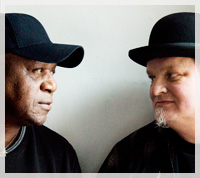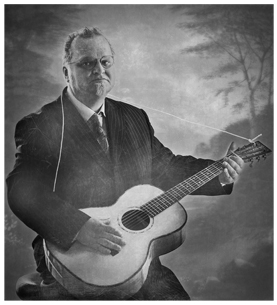| Master of Strings | ||
|
Knut Reiersrud (1961) is known to most people as a guitarist. It's now thirty years since he had the honour of playing with his legendary heroes. Since then he has played at 6,000 concerts, made more than 300 records, and 10 under his own name, and in between times learned to master ten different string instruments. The problems arise when you try to explain what kind of guitarist he is. A man who always travels around with eight guitars because they have been tuned differently according to where the music comes from is versatility personified.
Reiersrud's unique talent shines out through allthis versatility. In some inexplicable way, he creates an aura around the notes that is pure Reiersrud, whether he is playing African, Indian, Norwegian or American folk music, whether he dwells sobbingly, dances with cat's paw virtuosity over the strings or is downright noisy. It sometimes sounds as though he is giving birth to the notes right there and then, possibly as a result of his never using a plectrum because he wants to be close to the strings. His playing seems to find the essence; it evidences fundamentality, understanding and a sense of origin. All this is due to his insatiable curiosity and enviable openness. On the other hand, he can also be surprisingly conventional, as when he maintains that modern blues consists of good and less good copies of the great masters. The blues were his entrée to an
unusually varied career, difficult to define but undoubtedly that
of an innovative stylist. With the Four Roosters, he recorded The advantage and disadvantage of
being such a specialized musician in such a
On the follow-up record in the same place, also at night five years later, they further developed the interface between European church music and folk music in cooperation with Danish folk singer Povl Dissing. Neither Christians nor non-Christians had ever heard hymns and folk songs performed like that before. When the guitarist and organist toured the churches, they caused mass migrations the like of which had only previously been seen at Christmas and Easter. Music was suddenly back in its origins, practical church music reinforcing a message and providing solace and strength for the congregation. Reiersrud's spellbinding charm has in no way diminished over the years. His body language and mimicry are still extraordinarily expressive as he communicates and dedicates himself to something even greater and more powerful than the music itself. The paths Reiersrud chooses to take
can hardly be called changes but rather The idea for Klapp ('95) came after the the Voss Jazz Festival in '94, when the applauding audience clapped in time to twelve singers and musicians from three continents. It plays around with all the forms of expression that can be created by the hands, continuing where Tramp left off with newly composed music and arranged traditional music from all over the world. The ultimate leap without a safety net came in the form of Soul of a Man in '98. Here he has both rhythm and blues on a complete R & B album that was never fashionably hatched out at a recording company office but re-experienced from stages, dressing rooms, waiting rooms and endless nighttime journeys.
As a studio musician, he is not merely a guitarist on an hourly rate producing sounds to order. Many assignments develop so much that he might just as well have been included on the cover as co-composer, co-producer or co-artist. He has also composed the music for four Norwegian movies and, with Iver Kleive, took part in the opening ceremony of the Olympic Winter Games in '94. They did the quiet bit. Much of Reiersrud's strength lies
in his comprehensive knowledge, thanks not only to his years of
experience but also to his interest in music theory. He is as flexible and accessible as his guitar. Music consists of three variable elements; the rhythmic, which is the pulse, the melody, which is the heart, and the harmony, which is the head. Time and time again he stresses that his base is intuition and emotion and therefore stands for the heart. No-one out here in the darkness of the concert hall has ever been in any doubt about that. - Jostein Pedersen Addendum: Album releases include SUB (1999) - an ensemble of songs and compositions from the last near 20 years. In early 2000, continuing Reiersrud and Iver Kleive's collaboration and adding Danish vocalist and national treasure Povl Dissing; the album "Den sigende dag" (The Blessed Day) was released. All of the song texts were written by Danish poet, N.F.S. Grundtvig (1783-1872). An author of over 1,000 songs, his poetry and political beliefs impacted both Danish and Norwegian culture. 2000 also saw the release of "4G" , a project that put together four of Norway's best guitarists.
During a tour in India and Nepal with The
Funky Homosapiens Knut was reunited with Vajra,
a band working to keep the folk music of Nepal alive. After three
concerts at the jazz festival in Kathmandu, poetically called “Jazzmandu”,
they walked over to Studio 2000, sat in a circle, took one microphone
each, and let loose. Nepalese music possesses a beauty and depth
that are difficult to describe with words. It is reminiscent of
the sounds of the more prominent Indian and Pakistani cultures farther
to the south, but its form is more “folky” and is based
more on short, catchy melodic phrases. For many years, the area
where this little country surrounded by huge mountains is found
has been associated with Shangri-La. This name has become the symbol
of paradise on earth since James Hilton wrote the book Lost Horizon
in 1933, about a mysterious, legendary land hidden in a valley deep
within the Himalaya Mountains. The people who lived in this land
enjoyed exceptionally long lives in perfect harmony, peace and happiness.
The music of Nepal runs like a murmuring brook through this landscape
of goodness. The CD, Himalaya
Blues, was released in January 2004.
VOODOO WITHOUT KILLING
CHICKEN - Knuts 7th solo album - was released in 2008.
The band from this session (an all star lineup of young players
from well known bands such, as Jaga Jazzist and Big Bang) was to
become Knuts touring band. In 2011 Knut and Mighty Sam McClain went back into studio - to record an "old school" soul album. The album is out on KKV (kkv.no) in Europe and on Valley Entertainment in the US. "One Drop Is Plenty" - as it is called - received overwhelming reviews internationally. Once again breaking new ground, in 2012 Reiersrud recorded an exceptional and innovative “blues meets 19th century classical music” album with his band and the famed Trondheim Soloists. This critically acclaimed album was entitled “Infinite Gratitude” and stunned audiences with their live performances.
|
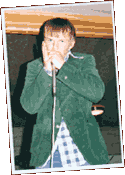
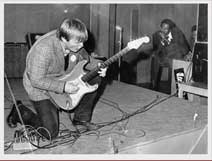
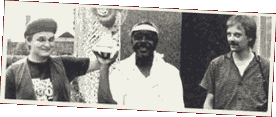 Rooster
Blues in '82. The following year he jammed with several of his
idols in the immortal Chess Studios in Chicago. That was the beginning
of the Chicago Blues Meeting group, which released Snake in My
Bedroom in '88. During that period, Knut Reiersrud was a concert
attraction and a public favourite. In beret, check jacket and extra
long guitar wire, he spent much of his time at overheated concerts
dancing with the audience while impeccably performing solo after
solo on guitar or harmonica. In actual fact, he was a down-to-earth
student who financed his studies by playing the clubs. When he discovered
that he was a member of six different bands at the same time and
was due to take an exam in Kant's moral philosophy, he finally realized
that he was a musician.
Rooster
Blues in '82. The following year he jammed with several of his
idols in the immortal Chess Studios in Chicago. That was the beginning
of the Chicago Blues Meeting group, which released Snake in My
Bedroom in '88. During that period, Knut Reiersrud was a concert
attraction and a public favourite. In beret, check jacket and extra
long guitar wire, he spent much of his time at overheated concerts
dancing with the audience while impeccably performing solo after
solo on guitar or harmonica. In actual fact, he was a down-to-earth
student who financed his studies by playing the clubs. When he discovered
that he was a member of six different bands at the same time and
was due to take an exam in Kant's moral philosophy, he finally realized
that he was a musician. 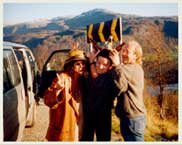 small
environment as Norway is that you have to go out and play to make
a living. Reiersrud became, and still is, a favourite studio musician
and has always spent a lot of time on the road. He believes he is
lucky to be able to play with so many good guitarists better than
himself and will never stop learning. He has worked with many different
stylists, such as Buddy Guy, Dr. John, Joe Cocker, Rick Danko, Sultan
Kahn, Stevie Ray Vaughn, David Lindley, the Five Blind Boys of Alabama
and El Subramanian. He has also delved into Norwegian folk music
in an unusual combination with Iver Kleive's church organ.
small
environment as Norway is that you have to go out and play to make
a living. Reiersrud became, and still is, a favourite studio musician
and has always spent a lot of time on the road. He believes he is
lucky to be able to play with so many good guitarists better than
himself and will never stop learning. He has worked with many different
stylists, such as Buddy Guy, Dr. John, Joe Cocker, Rick Danko, Sultan
Kahn, Stevie Ray Vaughn, David Lindley, the Five Blind Boys of Alabama
and El Subramanian. He has also delved into Norwegian folk music
in an unusual combination with Iver Kleive's church organ. 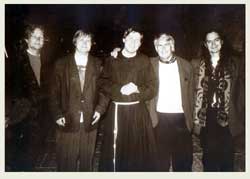
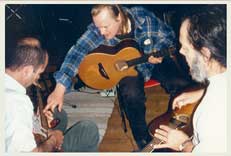 extensions
of style. From the sounds and intellectualism of the churches, it
seems only natural for him to begin investigating the instinctive
aspect of rhythm. On
extensions
of style. From the sounds and intellectualism of the churches, it
seems only natural for him to begin investigating the instinctive
aspect of rhythm. On 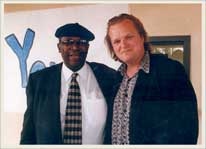
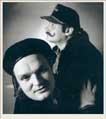 He
is so incredibly curious! He has systematized his knowledge to such
an extent that he is today an authority on older traditional music,
not least in the radio program Blå minutter(Blue Minutes) with Harald
Are Lund, Norway's John Peel. He defines himself objectively as
follows: The expression is blues, the packaging is typically West
European Beatles tradition and the sound is oriental, Indian and
African folk music mixed with the Norwegian Hardanger fiddle!
He
is so incredibly curious! He has systematized his knowledge to such
an extent that he is today an authority on older traditional music,
not least in the radio program Blå minutter(Blue Minutes) with Harald
Are Lund, Norway's John Peel. He defines himself objectively as
follows: The expression is blues, the packaging is typically West
European Beatles tradition and the sound is oriental, Indian and
African folk music mixed with the Norwegian Hardanger fiddle!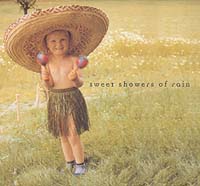
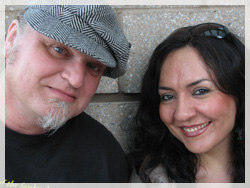 In 2007
Knut traveled to Teheran, Iran - arranged music for The Vahdat Sisters
and actually recorded a live CD,
In 2007
Knut traveled to Teheran, Iran - arranged music for The Vahdat Sisters
and actually recorded a live CD, 